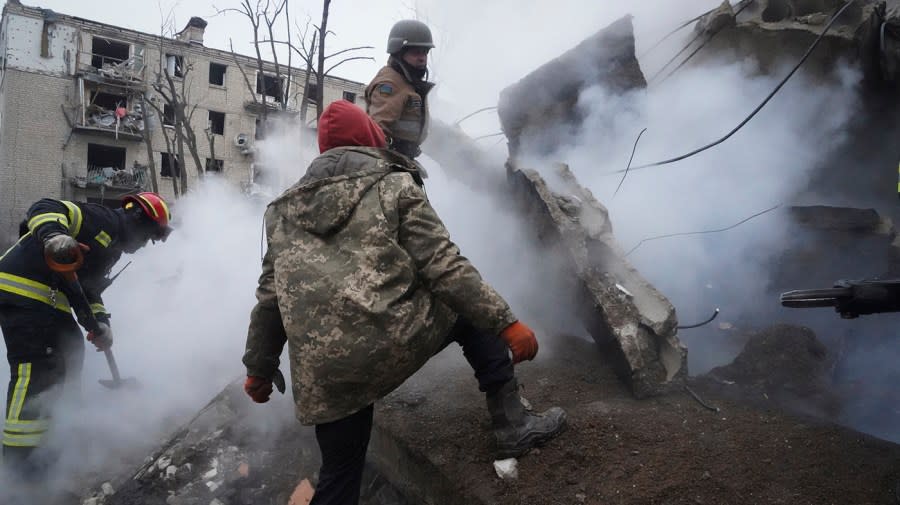How the Ukraine war ramped up Russia’s reliance on nuclear weapons

- Oops!Something went wrong.Please try again later.
The war in Ukraine has shifted Russia’s posture on nuclear weapons as Ukraine’s defenses, backed by Western help, have shown the limits of Kremlin conventional weapons and isolated Moscow.
Russian President Vladimir Putin — who has warned of “consequences that you have never faced in your history” should the West interfere in Ukraine — could resort to smaller nonstrategic nuclear weapons (NSNWs) to force the war to end on his own terms, or to gain the upper hand in a future conflict with NATO, according to a new report.
While the use of nuclear weapons has long been seen as unrealistic given the threat of escalation, Russia, “knowing that the West is casualty and risk averse … may seek to use enough NSNW to inflict damage preventing its own defeat,” states the report by the International Institute for Strategic Studies (IISS), released Monday.
“[Russia knows] the US would be unwilling to cross the nuclear threshold in retaliation, and may be willing to terminate the conflict early,” the report adds.
NSNWs, also known as tactical nuclear weapons, are low-yield weapons such as nuclear mines, artillery, torpedoes and some gravity bombs intended for use on the battlefield.
As opposed to longer-range strategic nuclear weapons — warheads delivered via intercontinental ballistic missiles, submarine-launched ballistic missiles or bombers — NSNWs can only travel up to 3,400 miles and can’t be used to hit faraway countries.
But even with their smaller scale, NSNWs still can deliver devastating consequences and pose a credible threat to the West.
As Russian forces stalled in Ukraine last spring and the U.S. shuttled billions of dollars’ worth of weapons to Kyiv, for example, Putin announced his intent to place NSNWs in Belarus. That deployment — the first time Moscow has sent nuclear weapons to a foreign country since 1962, and brought Kremlin weapons to NATO’s doorstep — was completed last month, according to Belarusian President Alexander Lukashenko.
William Alberque, who penned the IISS report, said there’s a recognition that Moscow will rely on nuclear weapons more in the time ahead, due to dwindling confidence in what’s worked and what hasn’t worked against Ukraine.
“They’ve always been very reliant on nuclear deterrence. I think there was some increase in confidence in their conventional capabilities, especially [10 years ago], but I think that confidence has eroded,” Alberque told The Hill. “The general trajectory is that Russia will rely much more upon nuclear weapons in the future for their feeling of security.”
Russia’s nuclear weapon use policy, signed by Putin in 2020, says Moscow may deploy Russia’s nuclear weapons “when the very existence of the state is put under threat.”
Since the start of the Ukraine-Russia war in February 2022, Putin has numerous times pointed to that policy in warning away any Western help, and staged intercontinental ballistic missile and experimental long-range missile tests.
In addition, Russia has walked away from major international nuclear agreements. Putin in November signed into law a bill revoking Moscow’s ratification of the Comprehensive Nuclear-Test-Ban Treaty, and last week Russia’s top diplomat rejected a U.S. proposal to continue nuclear arms control talks.
Russia, meanwhile, has denied its actions as brandishing nuclear threats.
But Putin’s nuclear saber-rattling has already been successful in deterring NATO from getting more involved in the war time and again, something that Moscow has taken note of, according to Chris Miller, a Russia expert at the Fletcher School at Tufts University.
“I think the entire world, Russia included, has been impressed by Russia’s ability to use nuclear threats to deter the West,” Miller told The Hill. “Russia didn’t even have to take really significant measures, just the mention of nuclear threats was an important factor in Western calculus about what types of aid to give to Ukraine at different periods of time.”
Case in point, the West has largely avoided steps that could lead to direct confrontation, with the U.S. so far refusing calls to impose a no-fly zone over Ukraine. Washington also dragged its feet on giving Kyiv systems it had long begged for, including fighter jets, M1 Abrams tanks, longer-range missiles and air defense systems.
U.S. officials have also repeatedly warned of severe consequences should Moscow deploy nuclear weapons, but have not publicly outlined what those consequences would be.
While the chance of Russia using tactical weapons against Ukraine in this conflict is low, Alberque said there is an “active discussion” in Kremlin think tanks and military circles on the topic.
That should signal to the West “that Russia is contemplating this much more than they were, say 10 years ago or 20 years ago,” he noted.
One bright spot for the West, however, is the lack of movement on Russia’s part in actually preparing to use a NSNW.
Other than the placement of the weapons in Belarus, there’s no other public movement of Russia’s nuclear forces, according to Heather Williams, director of the Project on Nuclear Issues at the Center for Strategic and International Studies.
“It does seem that Russia is relying on nuclear threats as a component of their wider Ukraine strategy. With that said, all we’re really seeing is rhetoric,” she said, adding that the West hasn’t seen any significant alteration in Russia’s nuclear posture.
“I think we need to keep watching this incredibly closely. But thus far, we have not seen Russia make any changes to suggest that nuclear use is imminent,” Williams added.
For the latest news, weather, sports, and streaming video, head to The Hill.

